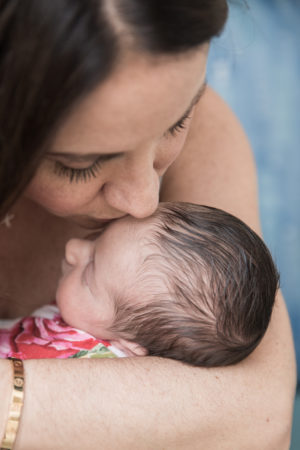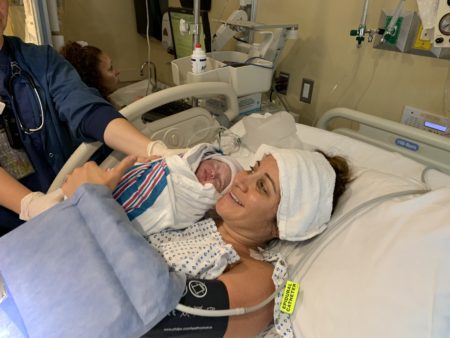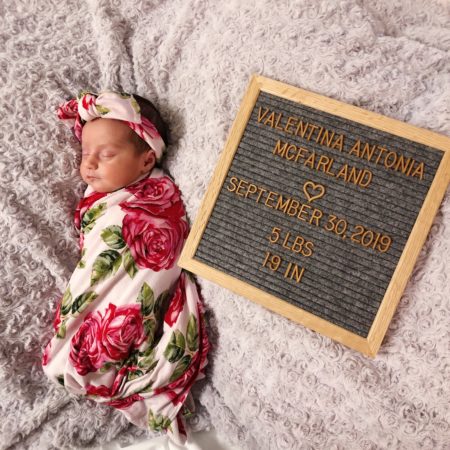
Photo Credit: Bella Baby PhotographyIf you missed my previous updates, you can catch up here:
My Third TrimesterOur Infertility Journey: We’re Having a Baby!
Our Infertility Journey: The IVF Decision
The day started like any other Sunday. After a night of restless sleep, I woke up early. David wanted to try a new brunch place so we walked the mile and a half from our apartment and back. After, I was tired (as usual) so I spent most of the afternoon relaxing on the couch. At around 4 p.m. we drove downtown to Whole Foods to do the weekly grocery shopping, came home, made dinner, watched some TV and went to bed.
I had no inclination that at 34 weeks and 5 days pregnant, I would give birth to our daughter. My third trimester had been uncomfortable, but I only had 5 1/2 weeks left to go. Having endured IVF and conquered hurdles during the first and second trimester, we were happy that the third trimester had been uneventful. In fact, when I asked my doctor if I could possibly give birth before my due date, he told me there was no indication that I would. But what I didn’t know at the time is that IVF pregnancies have an 80 percent higher risk of preterm birth before 37 and 34 weeks gestation.
At 2 a.m. I woke up to a trickle of liquid coming out of me. Groggy and confused, I went to the bathroom and questioned whether the liquid was in fact urine. I changed my underwear and went back to bed, but the trickle continued so I went back to the bathroom. By then, I was certain that the steady stream of liquid now flowing from me was not urine. I woke David and we agreed to call my doctor. Luckily, he was on call that night, mumbled something about ruptured membranes told me to go to the hospital.
I had a half-packed hospital bag I was still working to fill, but was optimistically certain this was not it – it was too soon. A quick Google search informed me I would be given some medication and put on bed rest. At most, I figured I would stay at the hospital overnight for observation. I opted to take a towel to sit on in the car instead.
Once we arrived at the hospital, I went right into triage and changed into a gown and socks. I was hooked up to monitors to measure contractions (I was contracting but couldn’t feel it) and track the baby’s heart rate. After lots of intake questions, the attending examined me and confirmed that the liquid was amniotoc fluid but I was not yet dilated.
When my doctor arrived, he told us very frankly that I was experiencing preterm premature rupture of membranes (PPROM) and that the baby would need to be delivered. David and I were speechless as we tried to process the news.
I had so many questions and fears in that moment, yet all I could manage to say was, “But we’re not ready.” My doctor explained that there was a greater risk of keeping the baby inside than there was of getting her out and that the survival rate for babies born after 34 weeks gestation is “excellent.”
Membrane ruptures occur in 8 to 10 percent of pregnancies but when the rupture is pre-term, the mother and baby are at greater risk as there’s a chance of infection. PPROM causes a third of preterm births.
My doctor explained the treatment plan – they would start an IV through which they would administer an antibiotic (to treat any possible infection) and a steroid injection, a last-minute effort to develop the baby’s lungs (lungs don’t develop until the last couple weeks of pregnancy) after which they would induce labor with pitocin. I could get an epidural at any time.
This was definitely not the birth I had planned or envisioned. While disappointing, I had no choice but to accept it and focus on staying calm and making the most of the labor and delivery I was having.
At around 5 a.m., I was admitted and assigned to a labor and delivery room. There was an ultrasound to look at the baby’s position – head down – and estimate her weight – 5 lbs. Although there is room for error on the weight estimate, it helped put my mind at ease knowing that she was already a healthy weight for a preemie. During this time, we also met with a NICU representative who explained what we could expect after the birth – she would be cleaned up, administered antibiotics to her eyes and a vitamin K shot in her thigh like all babies get – and then taken to the NICU. There would be no skin to skin and she would not be able to “room in” with us during our stay. I was saddened and scared, but at that point all I cared about was delivering a healthy baby and hopefully without the need for a C-section.
After the antibiotic and the steroid and just as the sun was rising, the pitocin started. The thing about pitocin is that it brings on labor strong and fast and my doctor ordered a “fast drip” on it. Even though there was so much of this labor that was out of my hands, I wanted to maintain the one plan I could still control and that was to go as long as I could without pain intervention. Soon after the pitocin started, I felt the contractions begin to build. I breathed deeply through them as I squeezed David’s hand. After two hours, I could no longer handle the pain and asked for the epidural.
Once the epidural was administered, David and I were able to get some much-needed sleep. I had about two hours of respite until the labor pains started to build again. I had envisioned a labor where I could move freely around the room, trying different positions, but because I needed continuous fetal monitoring and had an epidural, I was confined to staying in bed on my back and sides only.
My doctor came into the room frequently to check my cervix for dilation and after some time with no progression, he inserted a Foley bulb, a catheter with a balloon on the end used to encourage dilation.
As the day continued, the labor pains began to build again becoming more intense and closer together. Even with the epidural, I could feel intense pressure doing my best to breathe through them. With each contraction, I could feel the baby moving lower until finally I felt the urge to push. I told the nurse I could feel her head and begged for her to let me push. She immediately called my doctor and he rushed into the room with a team of maybe eight other people from attendings tp NICU nurses. I joked that I had an audience. My doctor did a final check on my cervix and told me to start pushing.
After 14 hours of labor and 15 minutes of pushing (the hardest and most painful 15 minutes of my life), Valentina Antonia McFarland was born on September 30 at 4:37 p.m. She weighed exactly 5 lbs. and was 19 inches long. They briefly put her on my abdomen and then she was taken away to get cleaned up. After, they put her back on my chest, briefly again, before whisking her off the NICU. David went with her.
Exhausted and starving, I was relieved it was over and elated that Valentina was healthy. The nurse cleaned me up, I ordered something to eat and was transferred to my room to start the process of recovery. Little did I know that as a preemie, Valentina would encounter many challenges in her first weeks of life requiring a two week stay in the NICU. This pregnancy was a roller coaster ride and I’m glad it’s behind us. We chose the name Valentina because it means “strong and healthy” and through it all she’s proven that she is.





Valentina is adorable!!!Congratulations,Marissa!!!
Thank you so much!